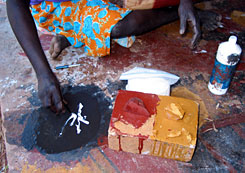
Painting on bark
Djambawa Marawili talks
about painting sea country. Interview filmed 2006. |
This is our law and our art. By painting these designs we are telling you a story. From time immemorial we have painted, just like you use pencil to write with. Yes we use our knowledge to paint from the ancient homelands to the bottom of the open ocean.Yolŋu elder [1]
Yolŋu paint on bark from the gadayka tree (stringybark gum). The barks are collected after the wet season rains when they are less likely to split. They are heated on a fire and then straightened under logs or other heavy objects.
Aboriginal bark paintings are more than just ochres on bark: they represent a social history; an encyclopaedia of the environment; a place; a site; a season; a being; a song; a dance; a ritual; an ancestral story and a personal history. Djon Mundine [2]
|
The paint comes from different sources: meku’ (red) and gangul (yellow)
are from rocks called ochres; gamunuŋgu (white) from a pure pipe clay; and mol (black) from manganese.
The different colours were traditionally ground and mixed with water and an adhesive of orchid juice, though nowadays this has been replaced by craft glue. To apply the paint Yolŋu use different tools. The fine lines are painted with brushes made from a few strands of fine, straight human hair.
1. Saltwater: Yirrkala Bark Paintings
of Sea Country, 1999
2. Ibid
